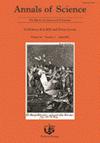物理数学和生命科学:体验静脉回流的机制,1650 -1680。
IF 0.5
3区 哲学
Q2 HISTORY & PHILOSOPHY OF SCIENCE
引用次数: 1
摘要
本文讨论后哈维生理学中解剖学的物理数学方法。但是,我并没有关注经常吸引这种方法的医疗力学和动物运动问题,而是关注血液如何回流到心脏的问题——这是今天被称为静脉回流的循环的一部分,但在现代早期研究得很少。我遵循不太知名的解剖学机械化作者提出的静脉回流机制,如Jean Pecquet(1622-1674)和Nicolaus Steno(1638-1686),以及更著名的Giovanni Alfonso Borelli(1608-1679)。他们的机制只是在小细节上有所不同。然而,这些微小的差异突出了17世纪生命科学机械化的重要方面。首先,他们比迄今为止所承认的更多地依赖于观察,即使只是间接的。其次,他们的机制更多地来自物理数学学科,而不是他们那个时代流行的微粒主义哲学。最后,这些机制导致了对循环的更准确的理解,这在今天仍然有效,从而揭示了它们的认知益处。简而言之,通过血液如何回流到心脏这一单一问题,这篇文章描绘了现代早期解剖学日益复杂的情况。本文章由计算机程序翻译,如有差异,请以英文原文为准。
Physico-mathematics and the life sciences: experiencing the mechanism of venous return, 1650s-1680s.
ABSTRACT This article deals with physico-mathematical approaches to anatomy in post-Harveyan physiology. But rather than looking at questions of iatromechanics and animal locomotion, which often attracted this approach, I look at the problem of how blood returned to the heart – a part of the circulation today known as venous return but poorly researched in the early modern period. I follow the venous return mechanisms proposed by lesser-known authors in the mechanization of anatomy, such as Jean Pecquet (1622–1674) and Nicolaus Steno (1638–1686), alongside the more famous Giovanni Alfonso Borelli (1608–1679). Their mechanisms differed only in small details. Yet, these minor differences highlight significant aspects of the mechanization of the life sciences in the seventeenth century. First, they relied more on observations than hitherto acknowledged, even if only indirectly. Second, their mechanisms drew more from the physico-mathematical disciplines than from the trending corpuscularian philosophies of their time. Finally, these mechanisms led to a more accurate understanding of the circulation that remains valid today, thus revealing their cognitive benefits. In short, through the single problem of how blood returned to the heart, this article portrays the increasing complexity of anatomy in the early modern period.
求助全文
通过发布文献求助,成功后即可免费获取论文全文。
去求助
来源期刊

Annals of Science
综合性期刊-科学史与科学哲学
CiteScore
0.80
自引率
0.00%
发文量
22
审稿时长
1 months
期刊介绍:
Annals of Science , launched in 1936, publishes work on the history of science, technology and medicine, covering developments from classical antiquity to the late 20th century. The Journal has a global reach, both in terms of the work that it publishes, and also in terms of its readership. The editors particularly welcome submissions from authors in Asia, Africa and South America.
Each issue contains research articles, and a comprehensive book reviews section, including essay reviews on a group of books on a broader level. Articles are published in both English and French, and the Journal welcomes proposals for special issues on relevant topics.
The Editors and Publisher are committed to supporting early career researchers, and award an annual prize to the best submission from current doctoral students, or those awarded a doctorate in the past four years.
 求助内容:
求助内容: 应助结果提醒方式:
应助结果提醒方式:


